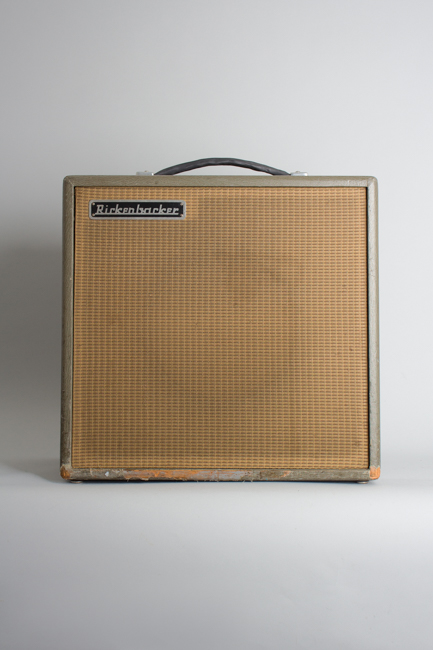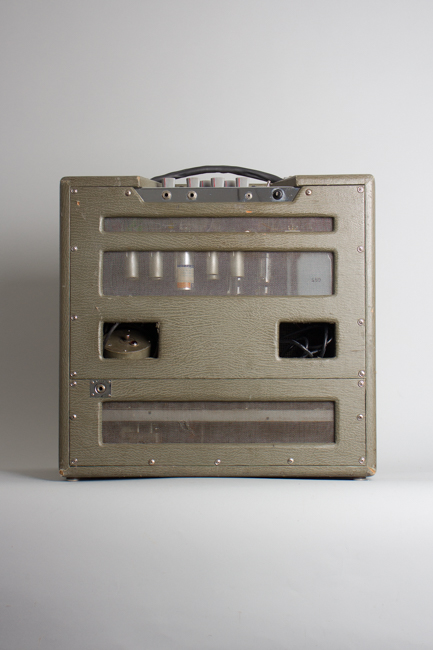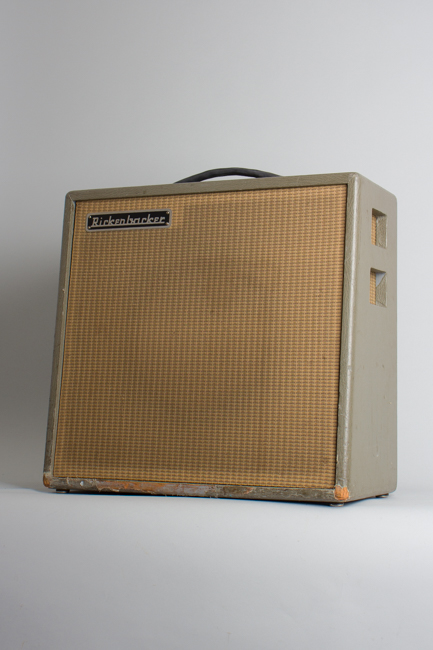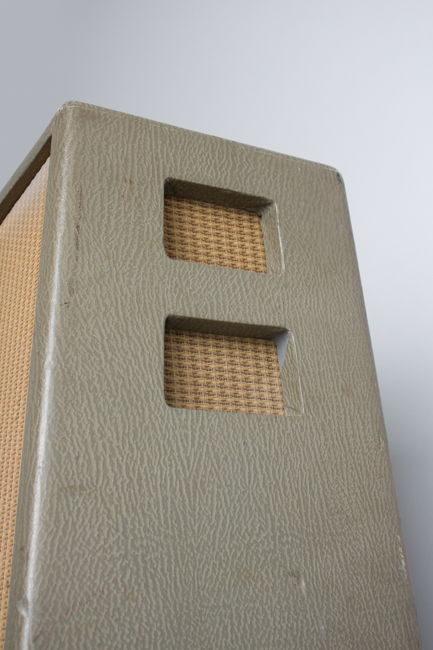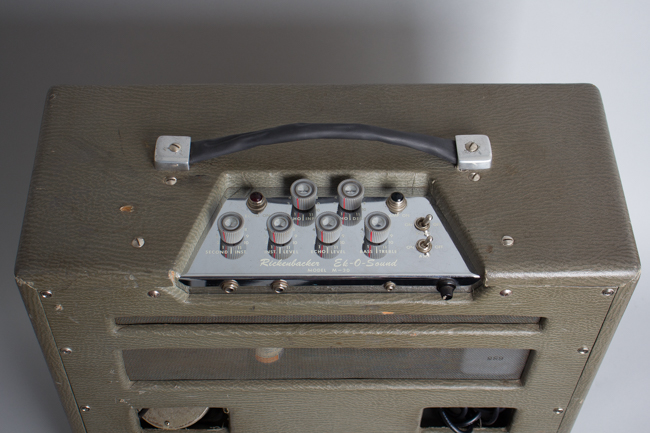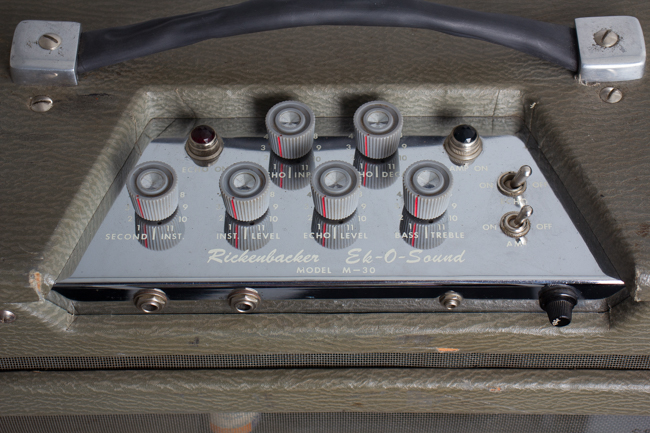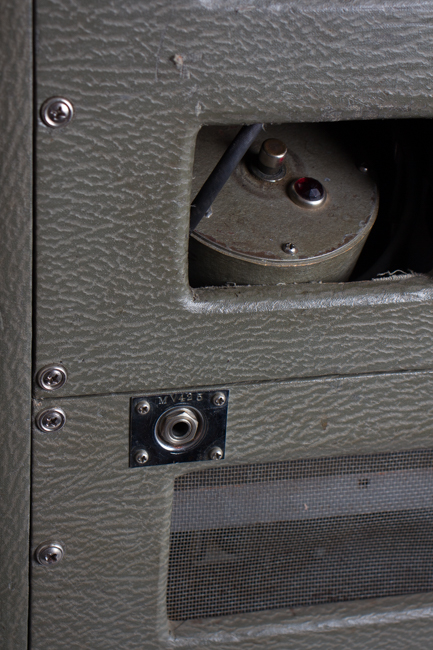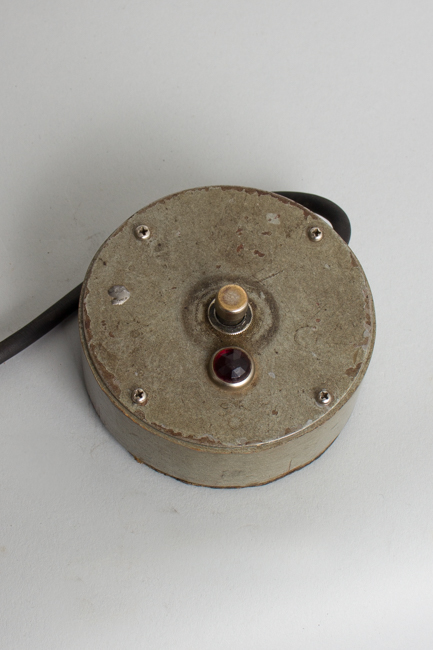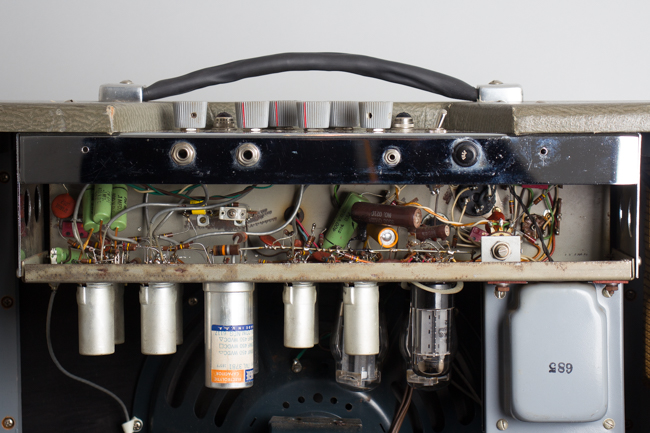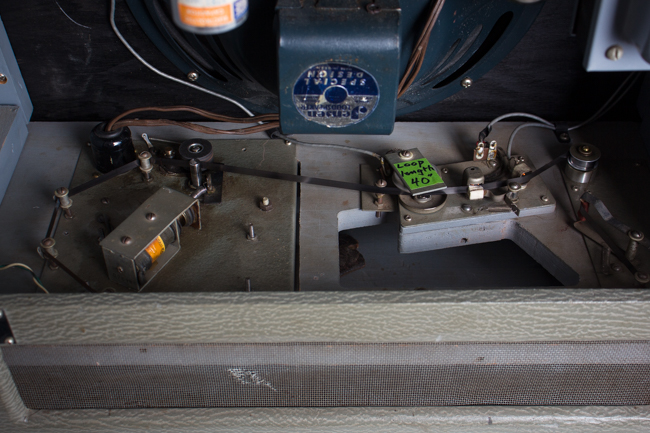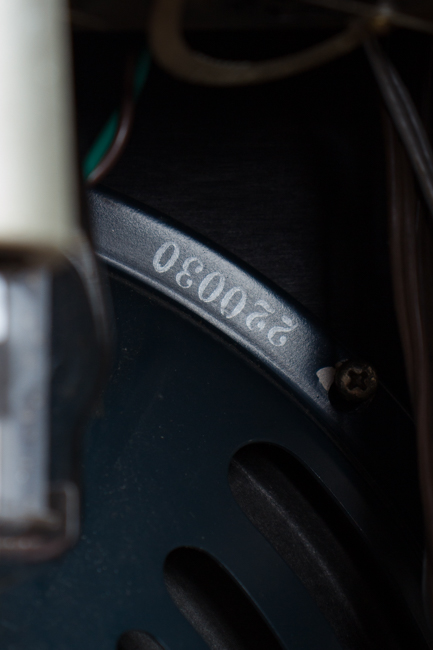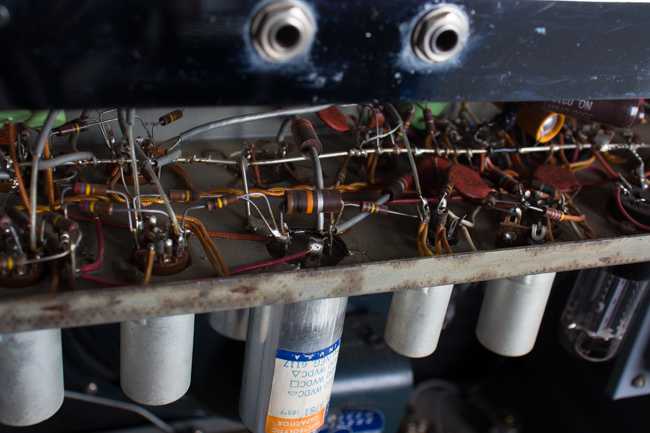Rickenbacker M-30 Ek-O-Sound Tube Amplifier (1960)
This item has been sold.
Item # 11548
Prices subject to change without notice.
Rickenbacker M-30 Ek-O-Sound Model Tube Amplifier (1960), made in Santa Ana, CA, serial # MV-425, grey/green fabric finish.
This extremely rare amplifier is the Rickenbacker factory version of one of the most iconic and interesting amps of the rock'n'roll era, the Ray Butts Echo-Sonic. Many recordings of the mid/late 1950s -- especially in the country and rock-a-billy genre -- made extensive use of tape echo. Outside the studio this left guitarists unable to reproduce their recorded sound on stage. Ray Butts came to the rescue. An engineer who owned a music store/repair shop in Cairo, Illinois, he hand built the first Echo-Sonic for a local guitarist to replicate Les Paul's slapback sound live.
Butts' design was based on a 15-watt Gibson amp; he added a built-in tape-loop at the bottom of the cabinet and tweaked the entire design to work as an integrated whole. After the success of the first one Butts realized he had something unique. He sold the next one to Chet Atkins who began using it straight away, employing the echo on several prominent recordings, including his famous rendition of "Mister Sandman". After Elvis hit big Scotty Moore was a customer, linking the amp to rockabilly lore for ever. "These amps have a magic sound," says our pal Deke Dickerson "it really only does one thing...but the one thing that it does has not been captured by any other amplifier before or since. Nothing has that sound but an EchoSonic."
Butts also designed the humbucking Filter 'Tron pickup for Atkins, who brought it to Gretsch. After assembling 40 or so of these amps he grew tired of hand-building them and in the late '50s licensed his patent to Rickenbacker. They put the amp into production but only sold them in very limited numbers, a staggeringly high list price of $773.50 by 1962 being a strong sales deterrent! Also by that time stand-alone tape echos like the Ecco-Fonic and Echoplex were coming to market for use with any amplifier, rendering this wonderful one-trick pony a dinosaur.
Rickenbacker's version was named the M-30 Ek-O-Sound and is generally true to the original design, if a bit more solidly made in places. The cabinet is covered in the same textured green/grey cloth as their period cases. The thoughtfully laid out top control panel features two volume controls, each situated next to its corresponding input. The instrument level controls are independent of the echo level, meaning it is possible to adjust balance exactly as desired and even kill the dry signal to only hear the echo. A "tilt" tone knob controls the balance of treble and bass. Situated above are controls for echo input level and decay (feedback). The loop tape delay (located at the bottom of the amp cabinet) has a fixed speed as a slapback echo and saturates beautifully as the echo input is raised. The tape delay mechanism is switched on by its dedicated power switch next to the main power switch. The effect can then be turned on/off with the dedicated footswitch.
The amp otherwise operates with a typical cathode-biased push-pull dual-6L6 circuit yielding around 30 watts. Ray Butts' handmade examples generally came with a 12" University UC121 speaker; Rickenbacker made amps use a more common Jensen P12Q. All these Ray Butts designed amps have achieved a sort of mythic status among connoisseurs; while usually described as less rare this Rickenbacker version is an equally difficult find. This example is easily the cleanest and most original we have ever seen, a spectacular and extremely rare find of a truly legendary amp.
Height is 21 in. (53.3 cm.), 22 in. (55.9 cm.) width, and 11 1/2 in. (29.2 cm.) deep.
This is simply a superb example of this rarest of amps. Externally, it shows some light general wear to the fairly fragile fabric covering, with dings and nicks heavier wear to the bottom edges, especially on the face where some fabric is worn away. It remains all original except for the handle, which is a later if functional improvisation. The control panel and original knobs are very clean. The original foot pedal is intact, showing some old stomp wear.
Electrically, this amplifier is all original. The original 12" Jensen P12Q speaker bears the code 220-030, dating it to the 30th week of 1960. It retains its original cone and sounds magnificent. The power and output transformers are original and marked 685 and 597, respectively. All pots, caps and other components appear original with the exception of the new 3-prong power cord. The amp works well including the elaborate tape section and sounds fantastic, not only with the classic "scotty' Rock-a-billy sound but also offering some truly interesting effects obtained by overdriving the echo or sending it into massive repeat mode.
DISCLAIMER: While we normally service all amplifiers for use, this nearly 73-year-old amp is nearly untouched, so we have elected in the interest of history to leave it that way. As such it is offered in AS-IS condition, not because of any damage or perceived flaw but due to its uniqueness, age and near all-original state. The amplifier HAS been tested and sounds remarkably great (and extremely low-noise considering the age of many components), however, if it is to be used regularly or as a reliable gigging/touring instrument without risk of damage or degradation, we would recommend it be professionally serviced to the level desired and we would be happy to do so upon sale. The electrolytic capacitors in the amplifier have aged many decades past their expiration dates to the point where we cannot guarantee their continued functionality and their failure could potentially cause damage to irreplaceable components. However, as it stands, this is an unaltered historic piece, an irreplaceable part of musical instrument history. Understanding that some would prefer to keep it unaltered, we leave it to the next owner to decide. Overall Excellent Condition.
This extremely rare amplifier is the Rickenbacker factory version of one of the most iconic and interesting amps of the rock'n'roll era, the Ray Butts Echo-Sonic. Many recordings of the mid/late 1950s -- especially in the country and rock-a-billy genre -- made extensive use of tape echo. Outside the studio this left guitarists unable to reproduce their recorded sound on stage. Ray Butts came to the rescue. An engineer who owned a music store/repair shop in Cairo, Illinois, he hand built the first Echo-Sonic for a local guitarist to replicate Les Paul's slapback sound live.
Butts' design was based on a 15-watt Gibson amp; he added a built-in tape-loop at the bottom of the cabinet and tweaked the entire design to work as an integrated whole. After the success of the first one Butts realized he had something unique. He sold the next one to Chet Atkins who began using it straight away, employing the echo on several prominent recordings, including his famous rendition of "Mister Sandman". After Elvis hit big Scotty Moore was a customer, linking the amp to rockabilly lore for ever. "These amps have a magic sound," says our pal Deke Dickerson "it really only does one thing...but the one thing that it does has not been captured by any other amplifier before or since. Nothing has that sound but an EchoSonic."
Butts also designed the humbucking Filter 'Tron pickup for Atkins, who brought it to Gretsch. After assembling 40 or so of these amps he grew tired of hand-building them and in the late '50s licensed his patent to Rickenbacker. They put the amp into production but only sold them in very limited numbers, a staggeringly high list price of $773.50 by 1962 being a strong sales deterrent! Also by that time stand-alone tape echos like the Ecco-Fonic and Echoplex were coming to market for use with any amplifier, rendering this wonderful one-trick pony a dinosaur.
Rickenbacker's version was named the M-30 Ek-O-Sound and is generally true to the original design, if a bit more solidly made in places. The cabinet is covered in the same textured green/grey cloth as their period cases. The thoughtfully laid out top control panel features two volume controls, each situated next to its corresponding input. The instrument level controls are independent of the echo level, meaning it is possible to adjust balance exactly as desired and even kill the dry signal to only hear the echo. A "tilt" tone knob controls the balance of treble and bass. Situated above are controls for echo input level and decay (feedback). The loop tape delay (located at the bottom of the amp cabinet) has a fixed speed as a slapback echo and saturates beautifully as the echo input is raised. The tape delay mechanism is switched on by its dedicated power switch next to the main power switch. The effect can then be turned on/off with the dedicated footswitch.
The amp otherwise operates with a typical cathode-biased push-pull dual-6L6 circuit yielding around 30 watts. Ray Butts' handmade examples generally came with a 12" University UC121 speaker; Rickenbacker made amps use a more common Jensen P12Q. All these Ray Butts designed amps have achieved a sort of mythic status among connoisseurs; while usually described as less rare this Rickenbacker version is an equally difficult find. This example is easily the cleanest and most original we have ever seen, a spectacular and extremely rare find of a truly legendary amp.
Height is 21 in. (53.3 cm.), 22 in. (55.9 cm.) width, and 11 1/2 in. (29.2 cm.) deep.
This is simply a superb example of this rarest of amps. Externally, it shows some light general wear to the fairly fragile fabric covering, with dings and nicks heavier wear to the bottom edges, especially on the face where some fabric is worn away. It remains all original except for the handle, which is a later if functional improvisation. The control panel and original knobs are very clean. The original foot pedal is intact, showing some old stomp wear.
Electrically, this amplifier is all original. The original 12" Jensen P12Q speaker bears the code 220-030, dating it to the 30th week of 1960. It retains its original cone and sounds magnificent. The power and output transformers are original and marked 685 and 597, respectively. All pots, caps and other components appear original with the exception of the new 3-prong power cord. The amp works well including the elaborate tape section and sounds fantastic, not only with the classic "scotty' Rock-a-billy sound but also offering some truly interesting effects obtained by overdriving the echo or sending it into massive repeat mode.
DISCLAIMER: While we normally service all amplifiers for use, this nearly 73-year-old amp is nearly untouched, so we have elected in the interest of history to leave it that way. As such it is offered in AS-IS condition, not because of any damage or perceived flaw but due to its uniqueness, age and near all-original state. The amplifier HAS been tested and sounds remarkably great (and extremely low-noise considering the age of many components), however, if it is to be used regularly or as a reliable gigging/touring instrument without risk of damage or degradation, we would recommend it be professionally serviced to the level desired and we would be happy to do so upon sale. The electrolytic capacitors in the amplifier have aged many decades past their expiration dates to the point where we cannot guarantee their continued functionality and their failure could potentially cause damage to irreplaceable components. However, as it stands, this is an unaltered historic piece, an irreplaceable part of musical instrument history. Understanding that some would prefer to keep it unaltered, we leave it to the next owner to decide. Overall Excellent Condition.
